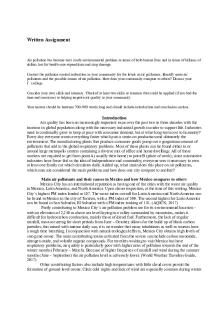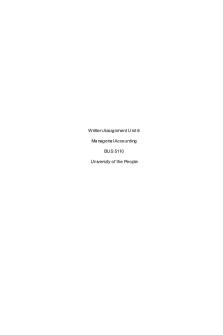ENVS 1301 - Written Assignment Unit 6 PDF

| Title | ENVS 1301 - Written Assignment Unit 6 |
|---|---|
| Author | Chuks Jedidiah |
| Course | Introduction to Environmental Sciences |
| Institution | University of the People |
| Pages | 2 |
| File Size | 106 KB |
| File Type | |
| Total Downloads | 49 |
| Total Views | 177 |
Summary
ENVS 1301 - Written Assignment Unit 6...
Description
Wr i t t e nAs s i gnme nt
Ai rp o l l u t i o nh a sb e c o mev e r yc o s t l ye n v i r o n me n t a lp r o b l e mi nt e r mso fb o t hh u ma nl i v e sa n di nt e r mso fb i l l i o n so f d o l l a r sl o s tf o rh e a l t h c a r ee x p e n d i t u r ea n dc r o pd a ma g e . Co n t a c tt h ep o l l u t i o nc o n t r o la u t h o r i t i e si ny o u rc o mmu n i t yf o rt h el e v e l so ra i rp o l l u t a n t s .I d e n t i f yma i na i r p o l l u t a n t sa n dt h ep o s s i b l ec a u s e so fa i rp o l l u t i o n .Ho wd o e sy o urc o mmu n i t yc o mp a r et oo t h e r s ?Di s c u s sy o u r fin d i n g s . Co n s i d e ry o u ro wns k i l l sa n di n t e r e s t s . Th i nko fa tl e a s tt wos ki l l so ri n t e r e s t st h a tc o u l db ea p p l i e d( i fy o uh a dt h e t i mea n dr e s o u r c e s )t oh e l p i n gi mp r o v ea i rq u a l i t yi ny o u rc o mmu n i t y . Yo u ra n s we rs h o u l db eb e t we e n7 0 0 – 9 0 0wo r d sl o n ga n ds h o u l di n c l u d ei n t r o d u c t i o na n dc o n c l u s i o ns e c t i o n .
Introduction Air quality has been an increasingly important issue over the past two to three decades with the increase in global population along with the necessary industrial growth in order to support life. Industries need to continually grow to keep at pace with consumer demand, but at what long-term cost to humanity? Every day everyone wants everything faster which puts a strain on production and ultimately the environment. The manufacturing plants that produce consumer goods pump out a gargantuan amount of pollutants that add to the global respiratory problems. Most of these plants can be found either in or around large metropolis centers containing a diverse mix of office and home dwellings. All of these workers are required to get from point A (usually their home) to point B (place of work); since automotive industries have force-fed us the idea of independence and commodity, everyone sees it necessary to own at least one family car which circulates daily. Added up, what strain does this place on air pollutants, which ones are considered the main problems and how does one city compare to another? Main air pollutants and their causes in Mexico and how Mexico compares to others Mexico City has an international reputation as having one of the cities with the worst air quality in Mexico, Latin America, and North America. Upon closer inspection, at the time of this writing, Mexico City´s highest PM index landed at 107. The worst index overall for Latin America and North America can be found in Mexico in the city of Torreon, with a PM index of 500. The second highest for Latin America can be found in San Salvador, El Salvador with a PM index ranking of 181. (AQICN, 2017) Partly contributing to Mexico City´s air pollution problem are for its environmental location – with an elevation of 2,250 m above sea level laying in a valley surrounded by mountains, makes it difficult for hydrocarbon combustion, mainly those of diesel fuel. Furthermore, the lack of regular rainfall, most occurring for short periods from June – October, allows for the build up of black carbon particles; this mixed with intense daily sun, it is no wonder that many inhabitants as well as tourists have a tough time breathing. In conjunction with natural ecological effects, Mexico City obtains high levels of smog and ozone. The main contributing toxins activated from the severe sun include carbon monoxide, nitrogen oxide, and volatile organic compounds. For travelers wishing to visit Mexico but have respiratory problems, air quality is particularly poor with higher rates of pollution towards the end of the winter months (February – March). Because of higher frequency of rainfall and wind during the summer months (June – September) the air pollution level is adversely lower. (World Weather Travelers Guide, 2017) Other contributing factors also include high temperatures with little cloud cover permit the formation of ground-level ozone. Clear cold nights and lack of wind are especially common during winter
months, however, this year there has been a significant amount of wind during the past month and a half helping to blow out air pollutants. Lastly, contributing to Mexico´s poor air conditions is its high-pressure system causing high atmospheric stability. (O'Connor, 2010) Each individual is responsible for the contribution of the current poor air quality that is experienced in our daily lives; therefore it is each individual´s responsibility to rectify the situation. Mexico City frequently experiences high levels of ozone; steps that I can personally take to help in lowering these levels are to commute less frequently and/or choose cleaner modes of transportation that reduce extra outbursts of pollution such as carpooling, taking transportation, or ideally, walking or biking to where I have to be. Another method that I can apply is reducing my use of electricity such as turning off lights in rooms that I am not in, change old light bulbs for newer energy efficient bulbs, not leaving the television turned on while not being used and unplugging unnecessary electronics when not being used. Conclusion Air pollution is an ever-growing problem even after we have become conscious of it and placed it at the forefront of environmental problems. In first world countries, for the most part, they have stepped up their game within their own borders by reducing emissions and greenhouse gasses, however, with globalization and demand of consumerism, they have increased the production of pollution in third world countries where their consumer goods are produced. This signifies that we must no longer be concerned what our individual country is contributing to the global problem of air quality but also what other countries are producing and the steps they are being taken in reducing their emissions.
Word Count: 741
References AQICN,. (2017). Air Pollution in Mexico: Real-time Air Quality Index Visual Map. aqicn.org. Retrieved 5 March 2017, from http://aqicn.org/map/mexico/ World Weather Travelers Guide,. (2017). Air pollution In Mexico City - How Bad Is It?. World-weathertravellers-guide.com. Retrieved 5 March 2017, from http://www.world-weather-travellers-guide.com/airpollution-in-mexico-city.html Kylie,. (2015). Causes of air pollution in Mexico | Help our polluted skies!. Blog.nus.edu.sg. Retrieved 5 March 2017, from https://blog.nus.edu.sg/kylie/2015/03/12/causes-of-air-pollution-in-mexico/ O'Connor, A. (2010). Mexico City drastically reduced air pollutants since 1990s. Washingtonpost.com. Retrieved 5 March 2017, from http://www.washingtonpost.com/wpdyn/content/article/2010/03/31/AR2010033103614.html...
Similar Free PDFs

Written Assignment Unit 6
- 8 Pages

Written Assignment Unit 6
- 4 Pages

Unit 6 - Written Assignment
- 4 Pages

ENVS 1301 UNIT 2 SELF-QUIZ
- 7 Pages

Written Assignment Unit 6 wa
- 4 Pages

Written Assignment Unit 2
- 3 Pages

Written Assignment Unit 7
- 3 Pages

Written Assignment UNIT 5
- 6 Pages

Written Assignment Unit 2
- 5 Pages

Written Assignment Unit 2
- 1 Pages
Popular Institutions
- Tinajero National High School - Annex
- Politeknik Caltex Riau
- Yokohama City University
- SGT University
- University of Al-Qadisiyah
- Divine Word College of Vigan
- Techniek College Rotterdam
- Universidade de Santiago
- Universiti Teknologi MARA Cawangan Johor Kampus Pasir Gudang
- Poltekkes Kemenkes Yogyakarta
- Baguio City National High School
- Colegio san marcos
- preparatoria uno
- Centro de Bachillerato Tecnológico Industrial y de Servicios No. 107
- Dalian Maritime University
- Quang Trung Secondary School
- Colegio Tecnológico en Informática
- Corporación Regional de Educación Superior
- Grupo CEDVA
- Dar Al Uloom University
- Centro de Estudios Preuniversitarios de la Universidad Nacional de Ingeniería
- 上智大学
- Aakash International School, Nuna Majara
- San Felipe Neri Catholic School
- Kang Chiao International School - New Taipei City
- Misamis Occidental National High School
- Institución Educativa Escuela Normal Juan Ladrilleros
- Kolehiyo ng Pantukan
- Batanes State College
- Instituto Continental
- Sekolah Menengah Kejuruan Kesehatan Kaltara (Tarakan)
- Colegio de La Inmaculada Concepcion - Cebu





